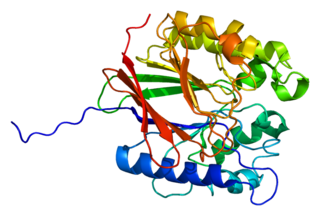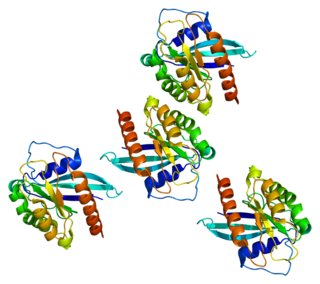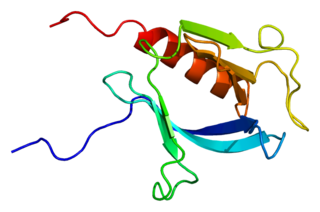
Tartrate-resistant acid phosphatase, also called acid phosphatase 5, tartrate resistant (ACP5), is a glycosylated monomeric metalloprotein enzyme expressed in mammals. It has a molecular weight of approximately 35kDa, a basic isoelectric point (7.6–9.5), and optimal activity in acidic conditions. TRAP is synthesized as latent proenzyme and activated by proteolytic cleavage and reduction. It is differentiated from other mammalian acid phosphatases by its resistance to inhibition by tartrate and by its molecular weight.

Ras-related protein Rab-7a is a protein that in humans is encoded by the RAB7A gene.

Dynamin-1 is a protein that in humans is encoded by the DNM1 gene.

Beclin-1 is a protein that in humans is encoded by the BECN1 gene. Beclin-1 is a mammalian ortholog of the yeast autophagy-related gene 6 (Atg6) and BEC-1 in the C. elegans nematode. This protein interacts with either BCL-2 or PI3k class III, playing a critical role in the regulation of both autophagy and cell death.

Chloride channel 7 alpha subunit also known as H+/Cl− exchange transporter 7 is a protein that in humans is encoded by the CLCN7 gene. In melanocytic cells this gene is regulated by the Microphthalmia-associated transcription factor.

Autophagy related 12 is a protein that in humans is encoded by the ATG12 gene.

Pleckstrin homology domain-containing family A member 5 is a protein that in humans is encoded by the PLEKHA5 gene.

Cytohesin-3 is a protein that in humans is encoded by the CYTH3 gene.

Pleckstrin homology domain-containing family B member 2 is a protein that in humans is encoded by the PLEKHB2 gene.

Pleckstrin homology domain-containing family F member 2 is a protein that in humans is encoded by the PLEKHF2 gene.

FERM, RhoGEF and pleckstrin domain-containing protein 1 is a protein that in humans is encoded by the FARP1 gene.

Oxysterol-binding protein-related protein 1 is a protein that in humans is encoded by the OSBPL1A gene.

Diacylglycerol kinase theta is an enzyme that in humans is encoded by the DGKQ gene.

Pleckstrin homology domain-containing family A member 6 is a protein that in humans is encoded by the PLEKHA6 gene.

Cytohesin-4 is a protein that in humans is encoded by the CYTH4 gene.

Vesicular glutamate transporter 3 (VGLUT3) is a protein that in humans is encoded by the SLC17A8 gene.
Pleckstrin Homology domain containing Family M Member 3, or PLEKHM3, is the hypothetical protein that in humans is encoded by the PLEKHM3 gene. PLEKHM3 is also known as DAPR, and Pleckstrin Homology Domain Containing Family M, Member 1-like.

Pacer is a protein that in humans is encoded by the RUBCNL gene. Pacer has been shown to increase cellular autophagy through regulation of PI3KC3.

Rubicon is a protein that in humans is encoded by the RUBCN gene. Rubicon is one of the few known negative regulators of autophagy, a cellular process that degrades unnecessary or damaged cellular components. Rubicon is recruited to its sites of action through interaction with the small GTPase Rab7, and impairs the autophagosome-lysosome fusion step of autophagy through inhibition of PI3KC3-C2.

The Rubicon homology domain is an evolutionarily conserved protein domain of approximately 250 amino acids that mediates protein–protein interaction. RH domains are present in several human proteins involved in regulation of autophagy and endosomal trafficking. While not all RH domains have been characterized, those of human Rubicon and PLEKHM1 mediate interaction with the small GTPase Rab7, which is found on late endosomes and autophagosomes.




















